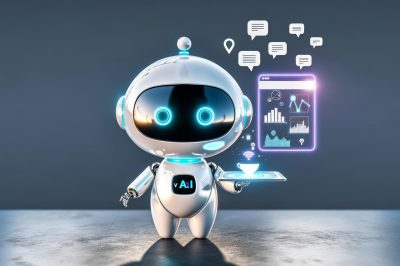AI’s Impact on Customer Engagement

Table of Contents
- AI’s Impact on Customer Engagement
- Debunking Myths About AI in Customer Service
- Cost-Efficiency: AI vs. Traditional Service
- Top Mistakes When Integrating AI into Customer Service
- The Future of Customer Service: Emerging AI Trends
- AI vs. Human Touch: Finding the Balance
- Breaking Down AI’s Role in Customer Satisfaction
- Why Some Businesses Still Resist AI
- How AI is Revolutionizing 24/7 Customer Support
- Revolutionizing Client Relationships with AI
Introduction
In a world where customer service is a crucial part of marketing strategy, small business owners in Swansea can greatly benefit from understanding the difference between AI-driven and traditional customer service methods. This blog post will explore the pros and cons of both, providing insights and strategies to help your business grow with marketing automation.
AI’s Impact on Customer Engagement
Debunking Common AI Myths in Customer Service
Many small business owners in Swansea wrestle with misconceptions surrounding AI in customer service, often hindering its adoption. Here we clarify prominent myths, illustrating how AI can indeed enhance customer interactions rather than diminish them.
1. Myth: AI Creates Impersonal, Generic Experiences
Reality: AI enables personalised self-service by analysing customer interactions to adapt responses dynamically. For example, Sony used AI to optimise conversational flows, achieving record customer satisfaction and operational efficiency. Modern chatbots incorporating natural language processing (NLP) can recognise emotional cues, allowing them to respond empathetically to frustrated customers.
2. Myth: AI Replaces Human Agents
Reality: Instead of replacing human roles, AI empowers employees by automating repetitive tasks and providing real-time guidance. SupportLogic’s platform has significantly reduced case review time, freeing agents to focus on more complex problems. Companies like Qlik and Nutanix have diminished escalations by employing AI to flag high-risk cases, showcasing how AI collaboration enhances human capabilities.
3. Myth: AI Is Limited to Self-Service and Automation
Reality: AI extends beyond mere automation; it can also analyse sentiment, predict trends, and inform business strategy. For instance, Open Network Exchange shifted a significant volume of payment calls to self-service using AI, easing the burden on human agents. Additionally, behavioural analytics can reduce customer effort, exemplified by Kaiser Permanente, where advancements in agent training improved interaction efficiency.
4. Myth: AI Is Only for B2C or Large Companies
Reality: B2B organisations can benefit immensely from AI, particularly in managing high-stakes accounts. Tools such as Kayako’s AI facilitate handling complex technical inquiries, allowing even small and medium enterprises (SMEs) to compete effectively without prohibitive costs.
5. Myth: Implementing AI Is Expensive or Complicated
Reality: Many purpose-built AI platforms integrate seamlessly with existing systems, requiring minimal training and offering user-friendly interfaces. Solutions tailored for SMEs ensure that businesses can deploy AI chatbots or analytics tools affordably, significantly boosting efficiency.
6. Myth: AI Risks Data Privacy
Reality: Reputable AI tools prioritise data security, countering fears related to customer data breaches. Many AI platforms emphasise compliance with privacy standards, ensuring the secure processing of sensitive information.
By dispelling these myths, Swansea businesses can leverage AI technologies to provide hyper-personalised, efficient, and empathetic customer service experiences, ultimately driving growth and customer loyalty.
Debunking Myths About AI in Customer Service
Traditional Customer Service Methods
Pros
- Consistency & Predictability
- Predefined workflows ensure standardised responses for common queries, reducing variability in service delivery.
- Scalability for High Volume
- Efficient for handling large volumes of requests through systems that prioritise urgent issues.
- Cost-Effective Short-Term
- Lower initial setup costs make traditional methods attractive for small businesses with limited budgets.
- Emotional Handling
- Human agents provide empathy and adaptability, essential for dealing with complex or sensitive customer issues.
Cons
- Limited Flexibility
- Often struggles with unique or nuanced queries, which can lead to customer frustration.
- Workflow Dependency
- Predefined scripts can limit problem-solving capabilities, reducing efficiency when issues fall outside the script.
- Scalability Challenges
- Requires additional staff or hardware to keep up with growth, which can increase long-term costs.
AI-Powered Customer Service Methods
Pros
- 24/7 Availability & Speed
- Instant responses for routine inquiries through chatbots, significantly reducing wait times for customers.
- Personalisation & Adaptation
- AI can tailor recommendations and responses based on customer data like purchase history, enhancing user experience.
- Cost Efficiency Long-Term
- Reduces staffing needs for repetitive tasks, helping to lower operational costs over time.
- Scalability Without Overhead
- AI can handle increased query volume without correspondingly increasing resources.
- Continuous Improvement
- Machine learning allows systems to enhance their response accuracy and efficiency dynamically.
Cons
- Lack of Empathy
- AI struggles with emotionally charged or complex issues requiring human discretion and judgement.
- Higher Initial Investment
- Setup costs for AI systems can be substantial, potentially challenging for small business budgets.
- Limited Contextual Understanding
- Potential for misinterpretations of nuanced queries, which can lead to customer dissatisfaction.
Cost Comparison
| Factor | Traditional | AI-Powered |
|---|---|---|
| Initial Costs | Lower (setup, training) | Higher (software, integration) |
| Long-Term Costs | Higher (staffing, maintenance) | Lower (reduced staffing) |
| Scalability | Linear (requires more staff/hardware) | Elastic (AI handles growth without additional costs) |
Best Practices for Small Businesses in Swansea
- Adopt a Hybrid Model
- Leverage AI for routine inquiries, while human agents manage complex issues that require a personal touch.
- Establish Clear Escalation Protocols
- Ensure seamless transitions from AI to human support to prevent customer frustration (e.g., a “speak to an agent” option).
- Utilise Predictive Analytics
- Monitor customer data to identify at-risk accounts or promote repeat buyers, enabling proactive engagement.
- Invest in Continuous Training
- Regular updates for AI platforms and training for staff will ensure the highest level of service quality.
Cost-Efficiency: AI vs. Traditional Service
When integrating AI into customer service, businesses often encounter several common mistakes that can hinder the effectiveness of their efforts. Here are the main pitfalls along with practical solutions to overcome them:
1. Overlooking Emotional Intelligence
AI systems that lack emotional intelligence may come across as cold or insensitive, potentially damaging customer relationships. These systems can mishandle sensitive communications, leading to customer dissatisfaction.
- Solution: Implement advanced natural language processing (NLP) technologies to enhance emotional cue detection. Providing empathy training for AI on varied scenarios can better equip it to respond to emotional cues.
2. Frustrating Conversational Loops
Poorly designed AI chatbots may trap customers in repetitive interaction loops, failing to provide resolutions. This leads to frustration and can diminish overall customer satisfaction.
- Solution: Integrate escape hatches and ensure there are smooth human handoffs for complex issues, so customers can easily transition to a human agent when needed.
3. Over-Automation Without Balance
While automation can streamline processes, over-relying on AI for every interaction may lead to depersonalised experiences, especially for complex issues that benefit from human judgment.
- Solution: Start automating simple tasks, like answering FAQs, and gradually expand. Establish hybrid support models where AI handles data retrieval, while human agents manage complex queries.
4. Poor System Integration
If AI systems operate in silos, they can fail to access essential customer data, resulting in fragmented interactions that frustrate customers.
- Solution: Ensure seamless integration with existing systems, such as customer relationship management (CRM) tools, by creating a unified data ecosystem.
5. Neglecting Feedback and Personalization
Disregarding customer feedback and failing to personalise interactions can lead to repeated information requests, increasing customer frustration.
- Solution:
- Gather feedback through post-interaction surveys to refine AI responses.
- Utilise customer history data to tailor support, as a significant percentage of customers expect recognition of past interactions.
6. Overlooking Governance and Scalability
Adopting AI without adequate governance frameworks or scalability considerations can result in inefficiencies and unfulfilled return on investment.
- Solution:
- Develop capability maps to ensure AI initiatives align with overall business goals.
- Explore agentic AI solutions for automating tasks that require complex reasoning while ensuring integration with APIs.
By addressing these common mistakes through careful planning and the integration of empathy-driven AI systems, businesses can enhance their customer service capabilities and foster stronger customer relationships.
Top Mistakes When Integrating AI into Customer Service
Key Trends in AI-Powered Customer Service for 2025
The landscape of customer service is evolving rapidly due to advancements in artificial intelligence (AI). As we look ahead to 2025, several key trends are shaping how businesses, including small enterprises in Swansea, will interact with their customers.
1. Agentic AI and Autonomous Decision-Making
Agentic AI will dominate customer service, enabling systems to make autonomous decisions aligned with business goals. This technology will streamline complex troubleshooting and optimize product recommendations, significantly reducing the need for human intervention for routine inquiries.
2. Hyper-Personalization and Proactive Support
AI will harness CRM integrations and historical data to anticipate customer needs, providing tailored solutions before issues arise, such as payment reminders or optimisation tips. This shift from reactive to proactive engagement will be fuelled by real-time analytics and deep customer insights.
3. Hybrid Human-AI Collaboration
In this paradigm, human agents will focus on high-value interactions while AI handles repetitive tasks like password resets or order tracking. Seamless handoffs between AI chatbots and humans, supported by customer context and interaction history, will enhance service continuity.
4. AI-Driven Automation and Efficiency
- Conversational Virtual Agents: NLP-powered chatbots will resolve routine queries at scale.
- Dynamic Call Routing: AI will optimise agent assignments based on expertise and customer data, ensuring personalised support.
- Workforce Management: Predictive analytics will forecast demand, allowing businesses to balance workloads and minimise wait times.
5. Advanced Analytics and Predictive Capabilities
AI will leverage voice interaction analysis for real-time sentiment detection, enabling agents to adjust their approach mid-conversation. Predictive analytics will also play a crucial role in anticipating customer churn and facilitating proactive retention strategies.
6. Integrated Self-Service and CRM
Self-service tools will evolve, allowing AI to assist customers with guided solutions and integrate smoothly with CRM systems, enhancing the user experience beyond basic FAQs.
7. Ethical AI and Data Security
As AI adoption grows, focusing on ethical implementation will be critical. Ensuring data privacy and transparency will help maintain customer trust, with safeguards needed to deliver personalised experiences without compromising security.
By 2025, it is anticipated that AI will handle 95% of customer interactions, allowing human agents to concentrate on empathetic, high-impact scenarios. This collaboration is poised to foster faster resolutions, deeper customer loyalty, and significant operational cost reductions.
The Future of Customer Service: Emerging AI Trends
AI vs Traditional Customer Service: Pros and Cons for Marketing Automation
AI-Driven Customer Service
Pros
- Automation Efficiency
- Handles repetitive tasks (refunds, order tracking, password resets) 24/7, providing immediate responses to customers without delays.
- Reduces labour costs by minimising the manual workload on customer service representatives, allowing businesses to allocate resources more effectively.
- Personalization and Data Insights
- Analyses customer behaviour to tailor recommendations, enhancing customer satisfaction and loyalty.
- Automated chatbots can resolve basic queries instantly, which frees human agents to focus on more complex issues.
- Scalability and Consistency
- Offers omnichannel support (chat, email, social media, voice) with standardised responses, ensuring a consistent customer experience across all platforms.
- Can predict trends (e.g., customer churn) to inform proactive strategies for customer retention.
Cons
- Human Interaction Limitations
- Over-reliance on AI can alienate customers who prefer human contact—57% of customers still favour phone support.
- AI struggles with nuanced or emotionally charged queries, which may lead to customer frustration.
- Technical and Ethical Challenges
- AI systems require ongoing training to mitigate data bias and improve accuracy, necessitating additional resources.
- Potential security risks and ethical concerns around data privacy may arise if not properly addressed.
Traditional Human-Driven Support
Pros
- Empathy and Complex Problem-Solving
- Better equipped to handle emotional or intricate issues (e.g., disputes, bespoke requests) through human understanding and empathy.
- Builds stronger customer relationships through personalised interactions, fostering loyalty and trust.
- Immediate, Tailored Responses
- Human agents adapt dynamically to unexpected scenarios, providing tailored solutions that AI may not handle as effectively.
Cons
- Cost and Resource Intensity
- Higher operational costs due to the requirement for staffing and training customer service representatives.
- Scalability Limitations
- Traditional support struggles to manage high query volumes or off-hour requests without the support of AI.
Comparison Table
| Feature | AI Advantages | Traditional Advantages |
|---|---|---|
| Automation | Handles repetitive tasks (e.g., FAQs, order tracking) | Limited to human capacity |
| Personalization | Uses data to predict needs and offer tailored recommendations | Relies on agent familiarity and intuition |
| Availability | 24/7 support with no downtime | Time-zone-constrained, human resources dependent |
| Complex Query Handling | Struggles with nuanced issues | Excels at resolving emotionally charged or intricate problems |
| Cost Efficiency | Reduces labour costs by automating routine tasks | Higher costs due to staff requirements |
Recommendations for Small Businesses
- Hybrid Model: Use AI for routine tasks (e.g., chatbots handling basic queries) while reserving human agents for complex issues.
- Transparency: Manage customer expectations by clearly indicating when interactions involve AI or humans.
- Ethical Monitoring: Regularly audit AI systems to address bias, ensure data privacy, and maintain ethical standards.
For small to medium enterprises (SMEs) in the UK, this balanced approach leverages AI’s efficiency while preserving the human touch crucial for customer loyalty and trust.
AI vs. Human Touch: Finding the Balance
AI and traditional customer service methods present distinct advantages and challenges for small businesses in Swansea. Embracing marketing automation through these methods can significantly enhance customer interaction and operational efficiency. Here’s a deep dive into how both styles compare, helping local businesses determine the best approach for their growth.
Efficiency and Scalability
AI-driven customer service automates repetitive tasks such as responding to FAQs and managing inquiries through chatbots. This technology allows for multiple simultaneous interactions, dramatically reducing response times and providing 24/7 availability to customers. Research indicates that AI agents can autonomously resolve up to 80% of customer inquiries, thereby alleviating the burden on human staff to handle only complex issues.
Conversely, traditional customer service relies on human agents who manage inquiries one at a time, which can lead to long wait times, especially during peak hours. While the personal touch of human interaction can be invaluable for resolving nuanced customer issues, it does limit scalability; as demand increases, so do the staffing costs.
Cost Implications
From a financial perspective, AI significantly lowers operational costs by reducing the workforce needed for repetitive tasks. Although initial investments in AI technology can be substantial, the long-term savings on staff and improved efficiency typically outweigh these costs. In contrast, traditional methods incur higher ongoing labour costs as businesses scale, making it less viable for long-term growth strategies.
Personalization and Insights
AI enhances customer personalization by leveraging data analytics. It can analyse purchasing history and customer interactions to tailor recommendations, thus increasing the likelihood of sales conversions. For instance, AI-driven Customer Relationship Management (CRM) systems can suggest specific promotions to individual customers based on past behaviour.
Traditional methods lack this deep analytical capability. Human agents can provide personalized recommendations but often rely on memory rather than data, limiting the effectiveness of their interactions.
Customer Experience
- Response Speed: AI methods offer instant replies, while traditional methods may involve longer wait times.
- Emotional Nuance: AI struggles with emotional context, whereas human agents excel in empathetic responses.
- Consistency: AI ensures uniform service quality, while traditional methods can vary in performance.
- 24/7 Availability: AI provides all-day support, while traditional service is confined to business hours.
Risks and Limitations
While AI brings numerous benefits, it also poses risks such as data security vulnerabilities and ethical concerns, including algorithmic bias. Businesses must regularly assess their AI systems to mitigate these risks. On the other hand, traditional customer service struggles with scalability and may lead to increased error rates as staff become overwhelmed during peak periods of demand.
Best Practices for Integration
To maximise customer engagement, small businesses in Swansea should consider a hybrid approach:
- Implement AI for Routine Tasks: Use chatbots to handle frequently asked questions and order tracking.
- Prioritise Human Interaction for Complex Cases: Reserve human agents for challenging inquiries needing emotional intelligence.
- Establish Ethical Guidelines: Regularly review AI interactions to comply with data protection regulations and maintain customer trust.
Breaking Down AI’s Role in Customer Satisfaction
Reasons Small Businesses in Swansea Might Resist Adopting AI Customer Service
Small businesses in Swansea are at a crossroads where technology and tradition intersect. While AI can offer numerous advantages for customer service, several factors contribute to their hesitance in adopting such technologies. Below are key reasons explaining this reluctance:
Operational and Cost Constraints
- Resource Limitations: Small businesses often operate on tight budgets, making upfront costs for AI integration or ongoing subscription fees prohibitive. Even with pay-as-you-go models, training employees to use AI tools or integrating systems may strain limited resources.
- Technical Complexity: Implementing AI requires technical expertise to configure chatbots, align workflows, and ensure compatibility with existing systems. Lack of in-house skills can deter adoption.
Cultural and Organisational Barriers
- Resistance to Change: Employees and owners may prefer traditional methods, fearing AI could disrupt established workflows or replace human roles. Concerns about job displacement might fuel internal resistance.
- Perceived Loss of Personal Touch: Small businesses, especially in community-focused areas like Swansea, prioritise human connection. They may worry AI could erode customer relationships or diminish the personalised service clients expect.
Trust and Quality Concerns
- Consumer Trust Gaps: While a significant percentage of companies plan to adopt AI chatbots, many consumers express distrust towards businesses using AI. Swansea businesses might hesitate to adopt due to fears of alienating customers.
- Accuracy and Oversight Challenges: AI systems can experience “hallucinations”—providing incorrect data—which necessitate human verification. Small teams may lack the bandwidth to monitor AI outputs, leading to hesitancy.
Strategic and Compliance Risks
- ROI Uncertainty: Despite reported efficiency gains, some businesses doubt tangible benefits. Without clear evidence of local success stories, they may prioritise tried-and-tested methods.
- Data Privacy and Compliance: Managing customer data with AI raises significant GDPR compliance risks. Small businesses may lack the expertise to ensure secure and lawful data handling.
Sector-Specific Hesitation
- Niche Customer Needs: Swansea’s local market might prioritise face-to-face interaction—critical for sectors like retail, tourism, or community services—making AI seem less adaptable to high-touch industries.
- Integration Challenges: Existing tools (e.g., CRMs, email systems) may conflict with AI solutions. Compatibility issues could deter adoption without appropriate IT support.
Recommendation: For Swansea businesses, starting with low-commitment tools (e.g., AI chatbots for basic inquiries) and transparently communicating AI usage to customers could ease the transition. Prioritising platforms with strong support can help mitigate technical hurdles.
Why Some Businesses Still Resist AI
AI vs. Traditional Customer Service for Small Business Marketing Automation
For small businesses in Swansea looking to enhance their marketing automation strategies, understanding the differences between AI-driven and traditional customer service methods is essential. Here’s a detailed comparison to help you navigate these options effectively.
Key Differences
Personalisation
AI systems excel at analysing customer data, such as purchase history and browsing behaviour, enabling hyper-personalisation. This allows for tailored messaging and product recommendations that traditional methods—usually reliant on manual segmentation—cannot match.
Automation Efficiency
AI automates numerous routine tasks including email scheduling and follow-ups. It can also manage high volumes of customer inquiries via chatbots, significantly reducing the workload for human agents. In contrast, traditional customer service methods often require manual interventions, making them less efficient.
Scalability
AI systems can scale effortlessly with customer growth, handling multiple inquiries simultaneously without the need for additional human resources. Traditional systems often struggle under increasing demand, leading to the necessity for hiring more staff to maintain service levels.
Complex Problem Handling
Human agents excel at navigating nuanced issues that require empathy and emotional understanding. Although AI can handle many queries automatically, it often fails in contexts needing complex judgement, necessitating staff intervention for resolution.
Cost Considerations
- Initial Costs: AI implementations typically incur higher upfront investments (e.g., for software development), whereas traditional methods have relatively lower initial costs linked to training staff.
- Operational Costs: AI can drastically lower ongoing operational costs due to reduced staffing needs, while traditional setups may see higher cumulative expenses from salaries and continuous training.
- Scalability Costs: The cost of scaling with AI can be minimal as it can handle increased volume efficiently, whereas traditional methods face significantly higher costs when expanding support teams.
When analysing cost efficiency and potential savings, many businesses find that although AI requires substantial initial funding, it offers long-term savings compared to traditional support systems which often lead to a steady rise in operational costs.
Hybrid Approach Recommendations
- AI for Routine Tasks: Use AI to handle FAQs, order tracking, and simple troubleshooting, freeing human agents for more critical tasks.
- Humans for High-Touch Engagement: Employ human representatives for complex concerns requiring empathy, such as customer complaints.
- Escalation Protocols: Establish clear protocols for seamless handoffs between AI and human agents to ensure that unresolved issues are efficiently escalated.
- Data-Driven Strategy: Utilise AI analytics to gather insights on customer behaviour and trends, enabling targeted outreach by human teams.
Future Trends and ROI
The impact of AI adoption in customer service is shifting from volume-based metrics (like tickets processed) to value-driven outcomes such as customer satisfaction and resolution quality. Small businesses that embrace AI-centric models can achieve accelerated growth without the linear scalability issues associated with traditional service techniques.
Challenges remain both for AI, which requires ongoing fine-tuning for accuracy, and traditional methods that are limited by workforce capacities and escalating costs. Therefore, for Swansea small businesses, harnessing a hybrid model that effectively combines AI efficiency with the nuanced touch of human service can prove to be the most successful strategy.
How AI is Revolutionizing 24/7 Customer Support
Key Comparisons
For a small business in Swansea considering marketing automation, choosing between AI-powered and traditional customer service methods involves balancing efficiency, cost, and customer experience. Here’s a structured analysis:
| Factor | AI-Powered Automation | Traditional Human Support |
|---|---|---|
| Scalability | Handles unlimited queries simultaneously | Limited by human agent capacity |
| Cost | Lower long-term operational costs (one-time setup) | Higher ongoing expenses (salaries, training) |
| Response Time | 50% faster resolution for simple inquiries | Slower during peak hours; limited by agent availability |
| Complexity Handling | Struggles with emotional/nonspecific issues | Excels at nuanced, sensitive, or creative problem-solving |
| Personalization | Tailored responses via customer data & machine learning | Human empathy and contextual understanding |
| Availability | 24/7 support | Restricted to business hours |
Pros of AI-Powered Automation
- Cost Efficiency: Reduces staffing needs and operational costs over time. Ideal for small businesses with limited budgets.
- Scalability: Manages high query volumes without performance degradation, crucial for growing customer bases.
- Speed & Consistency: Delivers instant, uniform responses, minimising wait times and reducing customer frustration.
- Data-Driven Insights: Analyzes customer behaviour for personalised marketing strategies and predictive support.
Cons of AI-Powered Automation
- Emotional Limitations: Struggles to resolve complex, emotionally charged issues.
- Initial Investment: Higher upfront costs for chatbot development.
- Potential Frustration: Customers may feel impersonal responses lack empathy.
Pros of Traditional Human Support
- Empathy & Adaptability: Builds trust through personalised interactions and creative problem-solving.
- Complex Issue Resolution: Handles ambiguous or emotionally sensitive inquiries effectively.
- Brand Loyalty: Human agents foster deeper customer relationships, critical for small businesses reliant on local reputation.
Cons of Traditional Human Support
- Higher Costs: Ongoing salaries, training, and infrastructure expenses.
- Limited Availability: Restricted to working hours, risking missed inquiries.
- Inconsistency: Response quality varies by agent experience and mood.
Recommendations for Small Businesses
- Hybrid Model: Use AI chatbots for routine tasks (FAQs, order tracking) and reserve human agents for complex issues.
- Prioritize AI for High-Volume Tasks: Automate repetitive workflows to free staff for strategic marketing.
- Budget Considerations: Start with basic AI tools to minimise initial costs, gradually investing in advanced solutions as needs grow.
- Customer Experience Balance: Use AI for customer feedback, then personalise human follow-ups to enhance loyalty.
For Swansea-based businesses, a blended approach maximises efficiency while preserving the human touch critical for local customer relationships.
Revolutionising Client Relationships with AI
AI vs. Traditional Customer Service Methods
In the landscape of customer service, small businesses often find themselves weighing the benefits of artificial intelligence (AI) against traditional methods. Understanding the core capabilities of both can help businesses in Swansea enhance their customer relations effectively.
Core Capabilities
- Response Speed: AI offers instant 24/7 support through tools like chatbots, allowing for immediate query handling. In contrast, traditional methods struggle with slower resolution times, especially during off-hours when human agents may not be available.
- Personalization: AI can tailor responses based on customer data, such as past purchases and interaction history. Traditional customer service relies on human intuition and manual record-keeping, which may not always access the necessary information timely.
- Scalability: AI can efficiently manage high inquiry volumes without significantly increasing costs. Traditional approaches often require hiring additional staff to cope with demand spikes, making them less scalable.
- Cost Efficiency: Automating routine inquiries through AI can drastically reduce operational costs, whereas traditional services incur higher labour expenses.
Benefits of AI
- Automation & Efficiency: AI tools can manage repetitive tasks such as order tracking, allowing human agents to focus on more complex issues.
- Data-Driven Insights: AI systems analyse customer interactions to identify trends, driving strategic decisions and marketing efforts.
- Cost Savings: Businesses can save significantly on operational costs by reducing the need for large support teams.
Benefits of Traditional Methods
- Human Empathy: In complex emotional scenarios, human agents are often preferable, providing a nuanced approach to problem-solving.
- Customization: Agents can offer on-the-spot tailored solutions that AI might not execute due to data limitations.
Drawbacks
- AI: While effective, AI lacks emotional understanding, which can lead to impersonal interactions.
- Traditional: Higher operational costs and slower response times hamper scalability.
When to Use Each Approach
- AI: Ideal for automating routine inquiries and high-volume support situations.
- Traditional: Best for handling complex issues and fostering long-term customer relationships.
Hybrid Model (Recommended)
Combining AI with human interaction can offer the best of both worlds. Deploy AI as the first line of contact, using chatbots for routine queries, and escalate more complex cases to human agents, equipped with context and insights drawn from AI analysis. This hybrid approach not only optimises efficiency but also ensures that sensitive issues receive the careful attention they require.
Sources
- NICE – Busting the Top 5 AI Myths Holding Back Your CX
- SupportLogic – 6 Common Misconceptions on AI-Powered Customer Service Debunked
- Kayako – 6 Myths and a Promise About AI in Customer Support
- Biz4Group – Traditional vs AI-Powered Customer Service Automation
- Airmeez – Comparing AI Chatbots and Traditional Customer Support
- Harvard Business Review – How AI is Changing the ROI of Customer Service
- DialZara – AI vs Human Customer Service: Pros, Cons, and Best Practices
- BizTech Magazine – How AI Transforms Customer Relationship Tech for Small Businesses
- Affordable Marketing Solutions: The Swansea Small Business Growth Plan Under £500/Month – 15 May 2025
- AI in Accounting Marketing: Leveraging Technology for Client Acquisition – 15 May 2025
- The Essential Legal Content Management System: Organize Your Thought Leadership for Maximum Impact – 14 May 2025






